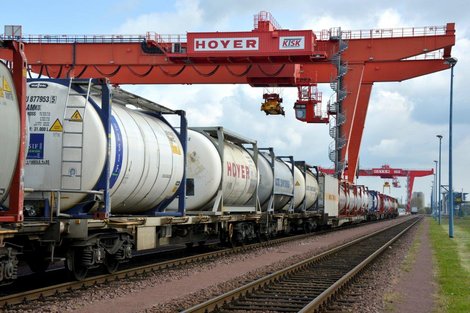Terminal expansion is a clear win for the site

Logistics centre HOYER in Schkopau has been increasing its capacities since May / interview with Logistics Manager Jörg Heilmann
Hamburg-based logistics company HOYER has expanded its combi-terminal in Schkopau in Saxony-Anhalt and at the same time created new transhipment and storage space. In the future, the public terminal will be able to handle up to 110,000 transhipment processes each year. Jörg Heilmann, Logistics Manager for HOYER GmbH at the Schkopau site speaks about why the traditional logistics company is based right in the heart of the chemical park, how the industry is perceived and why it is important to build up networks.
At the beginning of May, HOYER completed the expansion of its transhipment terminal for containers; what are the advantages this has brought?
Jörg Heilmann: The expansion means that considerably more trains can be rolled in and worked on parallel to each other across their whole lengths, resulting in shorter handling times. The platforms are now 600 metres in length, having been extended by more than 200 metres. With the terminal expansion, storage space has also been expanded by around 1,000 twenty-foot equivalent units (TEU) and the handling area has grown by around 2,000 square metres. We can now annually process up to 45,000 more loading units than before. We have also restructured our terminal so that straightforward traffic management with limited access control is possible, and a second container portal crane has been installed by construction company Kranbau Köthen. In conclusion, handling times are becoming shorter and productivity is increasing - the expansion is a clear win for the terminal.
What does the Central German logistics region get out of it?
We can now further consolidate rail services that are not covered by transhipment company Deutsche Umschlaggesellschaft Schiene-Straße (DUSS). The Schkopau junction has been expanded and has become more attractive. We are providing railway companies very good opportunities for the transhipment of their containers in every respect - and in a very flexible way.
Are networks important to you?
In practice, economic networks are part of our business principles. The opportunity to build a hub, or a central goods handling site, is becoming more likely. The junction construction I have already mentioned will also lead to improved offers that individual rail service companies can benefit from. Thanks to increased capacities, it will be possible for transport operations to pass through the north-south and west-east axes. Of course, we are also represented as a company in networks and clusters within this sector, in order to keep up with the times and consistently represent the views of the market.
Why did the company decide more than ten years ago to carry out its activities from this very location - between Halle and Leipzig?
A very good infrastructure has developed in the area between Halle, Leipzig and Bitterfeld, which means many opportunities for this sector.
Shortly after the Berlin Wall came down, our company opened its first small branch in the Bitterfeld-Wolfen region. We contacted the Dow Group relatively quickly, which has now been operating for over 20 years in the local chemical region. In 1998, we were able to spark the interest and therefore acquire the commercial spaces of Dow for purification and a haulage site and, the plant logistics for bulk and hazardous goods transport from the Schkopau plant, by winning calls for tender. For us, all the site advantages were present here that enable basic operations directly on-site. We are established here right in the chemical triangle between Bitterfeld, Leuna and Schkopau, from which we can serve our clients centrally. All of this together was a decisive factor in deciding on the Hoyer site.
Photo: Old and new crane - Schkopau terminal
Author: Manuela Bock
